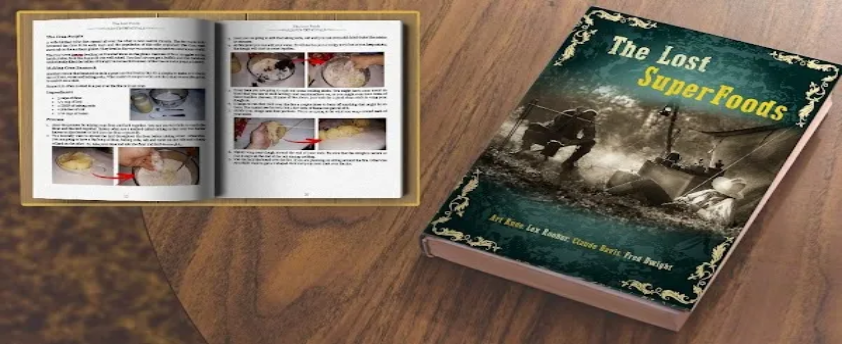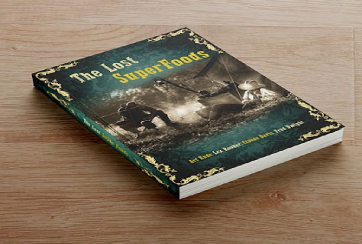Table of Contents
Introduction to The Lost Superfoods
“The Lost Superfoods” serves as an indispensable guide for survivalists, compiling over 126 forgotten survival foods and essential storage hacks. In an era where unpredictability reigns, having a well-stocked reserve of long-lasting foods can make all the difference in an emergency. This guide is not merely an assortment of recipes; it is a thoughtfully curated collection that emphasizes foods capable of sustaining individuals and families over extended periods without the need for refrigeration.
Long-lasting food items are crucial in times of crisis, whether due to natural disasters, economic instability, or unforeseen emergencies. These superfoods have been meticulously selected, drawing on historical knowledge and modern nutritional science, to offer a diverse range of options that ensure both sustenance and nutritional balance. The guide delves into foods that have stood the test of time, many of which were staples for our ancestors and have since been overshadowed by modern conveniences.
Incorporating these forgotten superfoods into your survival stockpile not only extends the longevity of your food reserve but also ensures a variety that is often missing in conventional emergency food supplies. From nutrient-dense grains and legumes to dried fruits and fermented vegetables, the guide covers an extensive array of options. Each entry is accompanied by detailed storage techniques, ensuring that these foods maintain their nutritional value and remain safe to consume over the long term.
Preparedness is not merely about amassing supplies; it is about making informed choices that guarantee sustainability and resilience. “The Lost Superfoods” bridges the gap between historical wisdom and contemporary needs, making it an essential resource for anyone serious about preparedness. With the right knowledge and provisions, navigating through emergencies becomes a matter of foresight and strategy, rather than mere survival.
Historical Importance of Forgotten Superfoods
The annals of history provide a treasure trove of knowledge about superfoods that were once integral to the daily diets of ancient civilizations. These forgotten superfoods, revered for their nutritional density and longevity-enhancing properties, played a pivotal role in the survival and prosperity of our ancestors. Many of these foods are documented in the book, offering insights into their historical significance and practical applications.
In ancient times, civilizations such as the Aztecs, Egyptians, and Greeks harnessed the power of superfoods to bolster health and vitality. For instance, chia seeds were a staple in the Aztec diet, prized for their ability to provide sustained energy. Similarly, the Egyptians considered honey not only a sweetener but also a potent medicinal substance due to its antibacterial properties. The Greeks, on the other hand, relied on figs, which were rich in calcium and fiber, to enhance their overall well-being.
These superfoods were not merely consumed for their taste but were deeply embedded in the cultural and medicinal practices of the time. The knowledge of such foods was passed down through generations, underscoring their importance in maintaining health and longevity. In a world where modern diets are often devoid of essential nutrients, revisiting these ancient superfoods can be immensely beneficial.
Understanding and incorporating these forgotten superfoods into our modern diets is crucial, particularly for survival purposes. In times of crisis or resource scarcity, nutrient-dense foods can provide the necessary sustenance to endure challenging conditions. Additionally, these superfoods often have a longer shelf life, making them ideal for stockpiling. By learning from the dietary practices of our ancestors, we can harness the power of these superfoods to enhance our resilience and overall health.

Key Features of The Lost Superfoods
“The Lost Superfoods” offers a comprehensive guide designed to enhance any survivalist’s food stockpile. One of its standout features is the extensive variety of foods it covers. The book delves into numerous superfoods that have stood the test of time, offering nutritional longevity and sustenance in survival scenarios. From ancient grains to nutrient-dense berries, the selection is curated to ensure maximum health benefits and energy supply during emergencies.
Another critical aspect of “The Lost Superfoods” is its practical storage hacks. It provides innovative techniques for organizing and storing food items, ensuring they remain viable over long periods. These hacks are particularly beneficial for those limited by space, offering solutions that optimize storage without compromising on the quantity or quality of food reserves. The book’s strategies encompass both modern and traditional storage methods, accommodating various needs and environments.
The preservation methods detailed in the book are also noteworthy. “The Lost Superfoods” emphasizes techniques that do not rely on refrigeration, a crucial factor in survival situations where electricity may be unavailable. Methods such as dehydration, fermentation, and canning are thoroughly explained, providing readers with the knowledge to maintain their food supplies effectively. These methods are chosen for their simplicity and efficiency, making them accessible even to those new to the concept of food preservation.
The practicality and usability of the information in “The Lost Superfoods” make it a valuable resource for both novice and experienced survivalists. Each section of the book is structured to offer clear, step-by-step instructions, ensuring that readers can implement the techniques with ease. The book also includes illustrations and tips to enhance understanding and application. Overall, “The Lost Superfoods” stands out for its user-friendly approach, making it an essential addition to any survivalist’s library.
Nutritional Benefits of The Lost Superfoods
The term “superfoods” refers to foods that are exceptionally nutrient-dense, offering a plethora of health benefits essential for maintaining a balanced diet, particularly in emergency situations. The Lost Superfoods book delves into a variety of these nutrient powerhouses, emphasizing their importance in a survival stockpile. These foods are not only rich in vitamins and minerals but also possess unique properties that make them invaluable during times of scarcity.
One notable superfood highlighted in the book is chia seeds. Packed with omega-3 fatty acids, fiber, and protein, chia seeds are a versatile addition to any meal. Their ability to absorb water and expand makes them an excellent source of hydration and energy. Additionally, they are rich in antioxidants, which can help combat oxidative stress, a common issue during prolonged periods of stress.
Another critical superfood covered is spirulina, a blue-green algae known for its high protein content and abundance of essential amino acids. Spirulina is also a rich source of B vitamins, iron, and calcium, making it a comprehensive supplement for maintaining overall health. Its antioxidant and anti-inflammatory properties further enhance its value as a survival food.
Honey, often hailed as a natural sweetener, is also a key superfood featured in the book. Its long shelf life and antimicrobial properties make it an excellent addition to a survival stockpile. Honey can provide a quick energy boost due to its high carbohydrate content and can aid in wound healing and infection prevention.
Elderberries are another superfood emphasized for their immune-boosting capabilities. Rich in vitamins A, B, and C, elderberries can help support the immune system, which is crucial during times when medical resources may be limited. Their antiviral properties can also be beneficial in preventing common illnesses.
These examples illustrate why the foods covered in The Lost Superfoods are considered superfoods. Their high nutritional value, long shelf life, and health benefits make them indispensable for anyone looking to maintain a balanced diet in emergency situations. By incorporating these superfoods into your survival stockpile, you can ensure that you have access to essential nutrients when they are needed most.
Practical Storage Hacks for Long-Lasting Food
The ability to store food effectively without relying on modern refrigeration is an invaluable skill, especially in survival scenarios. The book “The Lost Superfoods” offers a comprehensive guide on various storage hacks that ensure your food remains edible for extended periods. These techniques, rooted in both historical practices and modern innovations, are designed to be straightforward yet highly effective.
One of the fundamental methods discussed is dehydration. By removing moisture from fruits, vegetables, and meats, you can significantly extend their shelf life. This process is simple and can be done using a variety of tools, from electric dehydrators to solar drying racks. The book emphasizes the importance of storing dehydrated foods in airtight containers to prevent reabsorption of moisture.
Another valuable technique highlighted is fermentation. This ancient method not only preserves food but also enhances its nutritional value. Fermenting vegetables like cabbage into sauerkraut or cucumbers into pickles creates an environment where beneficial bacteria thrive, effectively preserving the food. The book provides step-by-step instructions to ensure successful fermentation.
Additionally, the concept of root cellaring is explored. This traditional method leverages the natural insulating properties of the earth to maintain a cool, stable temperature ideal for storing root vegetables, fruits, and even some dairy products. A root cellar can be as simple as a buried barrel or a dedicated underground room, making it accessible for various living situations.
A lesser-known but particularly useful technique covered is the use of wax sealing. By dipping cheese or other perishables in melted wax, you create an airtight seal that protects the food from spoilage. This method is not only effective but also easy to implement at home.
These practical storage hacks, among others detailed in “The Lost Superfoods,” offer a reliable way to ensure your food supply remains safe and nutritious over time. By integrating these methods into your survival preparations, you can build a robust and resilient stockpile that stands the test of time.
‘The Lost Superfoods‘ is a compelling recommendation for anyone devoted to survival preparedness. The book’s meticulous exploration of forgotten superfoods offers invaluable insights into nutritional staples that many modern diets overlook. These superfoods are not only nutrient-dense but also possess remarkable shelf lives, making them ideal for long-term storage. The inclusion of these foods in one’s emergency stockpile ensures a balanced diet rich in essential vitamins and minerals, which is critical during times of crisis.
One of the standout features of ‘The Lost Superfoods’ is its practical storage hacks. The book dives into innovative methods to preserve these superfoods, extending their longevity while maintaining their nutritional value. These techniques are indispensable for anyone aiming to build a robust and reliable food stockpile. From ancient preservation methods to modern-day techniques, the book covers a gamut of strategies, providing readers with actionable advice that can be implemented immediately.
Moreover, ‘The Lost Superfoods’ serves as a comprehensive guide, making it accessible to both novices and seasoned preppers. The clear, step-by-step instructions ensure that even those new to survival preparedness can effectively utilize the information. This inclusivity enhances the book’s value, making it a vital addition to any household’s emergency planning resources.
In times of uncertainty and unforeseen situations, having a well-curated food stockpile can make a significant difference. ‘The Lost Superfoods’ equips individuals with the knowledge to create a stockpile that is not only enduring but also nutritionally adequate. This preparation fosters a sense of security and self-reliance, crucial attributes in any survival scenario.
In essence, ‘The Lost Superfoods’ is an essential read for anyone serious about survival preparedness. Its thorough coverage of nutrient-rich, long-lasting superfoods combined with practical storage solutions makes it an invaluable resource. By integrating these forgotten superfoods into their emergency stockpile, individuals can ensure they are well-prepared for any eventuality, thereby safeguarding their health and well-being.





